Have you ever come across a baking term in a recipe and you weren’t sure what it meant? Baking is a craft, a mixture of science and art. Understanding proper technique, along with using precise measuring, are both keys to success. Here we’ll define some basic baking terms that are sure to give you a confidence boost next time you reach for a recipe.
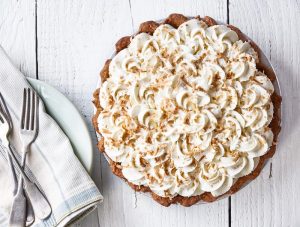
1 — Blind Bake
Blind baking, or pre-baking, is the process of baking a pie crust without a filling. Blind baking is called for when a crust will be used with an unbaked filling, such as with pudding or cream pies, in which case the crust must be fully baked first. Some recipes may call for partial blind baking to ensure a fully baked crust when making a baked custard-like pumpkin or chess pies.
Tip: to ensure a crust that doesn’t shrink or bubble, bake a well-chilled dough that is docked (see below), lined with parchment paper, and filled with dry beans or pie weights.
2 — Dock
To dock a pastry means to prick the surface with a fork or a docking tool before baking. This allows steam to escape and keep the dough from creating bubbles or puffing up in the oven. This technique is used when blind baking a pie crust before filling, but also for some puff pastry, focaccia, and other doughs.
 3 — Cream
3 — Cream
Have you ever been confused when recipe instructions say “cream”, but there is no cream called for in the ingredients? That’s because they are referring to using the creaming method. This is a mixing method for combining sugar and fat into a smooth paste and incorporating some air. The light and fluffy mixture is the first step of most cookie dough and cake batter recipes.
4 — Cut In
If a recipe calls to “cut in” the butter or fat, this means to distribute a solid fat into flour using a cutting motion. It can be done with a pastry blender (a tool with curved blades attached to a handle) or two knives used in a scissors-fashion. You can also use your fingers. The goal is to divide the cold fat into small, even pieces that will steam during baking and add flaky layers to your baked goods. This technique is used for scones, biscuits and pie doughs.
5 — Knead
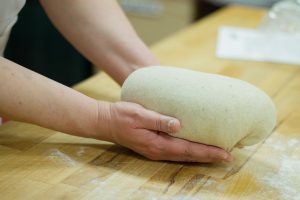 This is the process of repeated folding and pressing the dough when making bread or pasta. A kneading motion lengthens the gluten strands and adds strength to the final product.
This is the process of repeated folding and pressing the dough when making bread or pasta. A kneading motion lengthens the gluten strands and adds strength to the final product.
Tip: Usually you will knead your dough on a clean, not floured work surface. Adding extra flour to your dough during kneading can have a negative effect on the flavor and texture of your final baked goods.
6 — Proof
Proofing, also known as rising or bulk fermentation, means to let a mixed and kneaded dough rest undisturbed. The length of time depends on the type of dough, but generally, the dough should double in size in this stage. During proofing, an anaerobic biological process occurs that converts sugars and starches into carbon dioxide. This is what causes the dough to rise. Proofing is typically used to refer to the final shaped loaf rather than the bulk fermentation, this is to distinguish fermentation that may be prolonged as in the case of the naturally leavened.
7 — Score
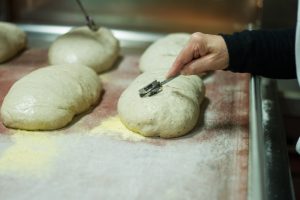 Scoring is cutting the surface of bread dough with a blade or a sharp knife. It serves both functional and aesthetic purposes. The opening allows you to control where the gas and steam will escape when the dough expands during baking so that you can have an attractive loaf. It is also an opportunity to decorate the loaf with patterns.
Scoring is cutting the surface of bread dough with a blade or a sharp knife. It serves both functional and aesthetic purposes. The opening allows you to control where the gas and steam will escape when the dough expands during baking so that you can have an attractive loaf. It is also an opportunity to decorate the loaf with patterns.
8 — Temper
Tempering ingredients in a recipe is to slowly bring up the temperature of an ingredient sensitive to heat, such as eggs or milk, to prevent it from curdling, breaking, or cooking too fast. It’s an important step for successful pastry cream, fruit curds, and so on. (Note that this isn’t the same process as tempering chocolate! Tempering chocolate is a way to stabilize chocolate so sets up nicely on dipped strawberries or chocolate-covered treats, it doesn’t melt as easily from the warmth of your hand, and it makes it look smooth and shiny.
9 — Laminate
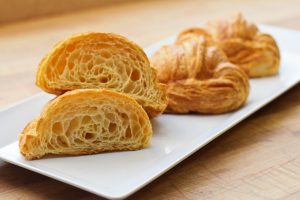 Laminated doughs create many thin layers in the final product. The dough is alternated with butter by repeated folding and rolling. When baked, the butter steams and separates the layers of dough. This is how croissants, danish and puff pastry get their characteristic flakey layers.
Laminated doughs create many thin layers in the final product. The dough is alternated with butter by repeated folding and rolling. When baked, the butter steams and separates the layers of dough. This is how croissants, danish and puff pastry get their characteristic flakey layers.
10 — Fold
The word fold in a baking recipe could refer to a few techniques, depending on what you’re making.
Batters:
If a cake batter or mousse calls for folding, you’ll combine the ingredients together gently without stirring or beating the mixture. It is a technique most commonly used when you are combining ingredients that have already been whipped, such as egg whites or cream. The gentle folding motion with a spatula from the bottom to the top of the bowl will prevent deflating the air in the mixture.
Laminated Doughs:
Folds are part of making laminated doughs (see above). Just like folding a paper letter, a series of folds are made to further layer the butter encased in the dough.
Yeast Doughs:
When you fold a yeasted dough after proofing you expel the carbon dioxide formed during fermentation, strengthen the dough by aligning and stretching the gluten strands, and equalize the dough’s temperature to eliminate hot spots. Older recipes will refer to ‘punching’ the dough down, but we prefer kinder language with our dough!
When you fold a yeasted dough after proofing you expel the carbon dioxide formed during fermentation, strengthen the dough by aligning and stretching the gluten strands, and equalize the dough’s temperature to eliminate hot spots. Older recipes will refer to ‘punching’ the dough down, but we prefer kinder language with our dough!
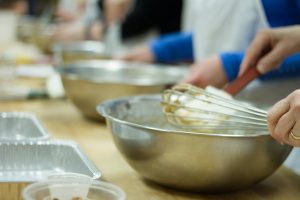
Keep the learning going!
READ ON
For even more detailed baking how-to’s and tips, as well as dozens of beloved recipes, check out Zingerman’s Bakehouse, the cookbook.
For stories behind the food, baking information, interviews with cookbook authors and bakers, and much more, visit our Zingerman’s Bakehouse Blog.
BAKE! WITH US
BAKE! is the hands-on teaching bakery at Zingerman’s Bakehouse. Since 2006 we’ve shared our knowledge and love of baking with home bakers, seeking to preserve baking traditions and inspire new ones. We more than 70 different hands-on baking classes, as well as special events and demonstrations. Browse the class menu.
INTERACT WITH BAKERS
Have you taken a class with us? Join our BAKE! Community Facebook Group, where baking class attendees and instructors share interesting baking articles, troubleshooting tips, requests for help and recipe successes. It’s nearly 3,000 members strong and a great place to find knowledge and inspiration.
Sara grew up in metro Detroit making her own birthday cakes and dreaming of a career in baking. At age 17 her path began with the Schoolcraft College Culinary Arts program, and at 18 she got her first job in the field right here in the pastry kitchen of Zingerman's Bakehouse. That work evolved over a couple of decades to include baking, customer service, cooking, project management, copywriting, and much more. She even helped to create BAKE! and this blog! Today, Sara leads the creative team at Zingerman's Service Network, supporting the blogs, websites, copywriting, packaging, and other marketing for Zingerman's Community of Businesses. Sara remains a die-hard fan of Pecan Pie, Pavlova, Paris Brest, Patti Pockets, and other desserts that start with 'P.'

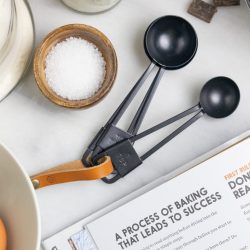
Thanks for sharing this helpful information! It’s quite an interesting topic. Waiting for your next excellent update.
Thanks for your comment! Glad you found it helpful!